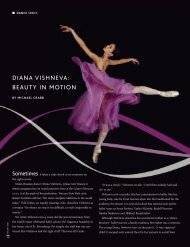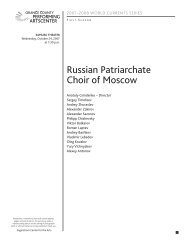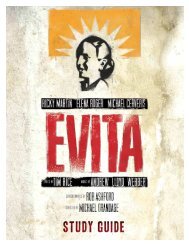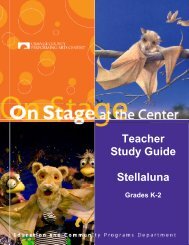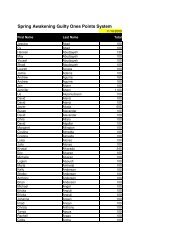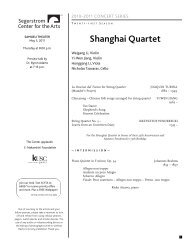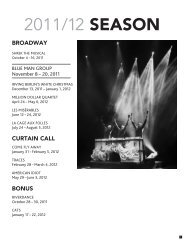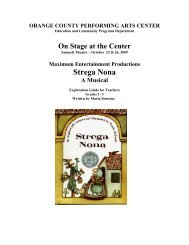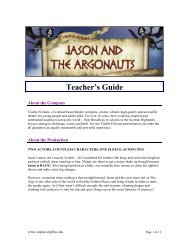SPRING AWAKENING - Segerstrom Center for the Arts
SPRING AWAKENING - Segerstrom Center for the Arts
SPRING AWAKENING - Segerstrom Center for the Arts
You also want an ePaper? Increase the reach of your titles
YUMPU automatically turns print PDFs into web optimized ePapers that Google loves.
History<br />
Writing<br />
Writing<br />
Objective<br />
Exploring women’s rights<br />
in two cultures.<br />
From <strong>the</strong> Script<br />
Act 1, Scene 2<br />
Most of <strong>the</strong> history you study in junior high and high school will be American history. Not<br />
much about German history will be discussed. There are many parallels between <strong>the</strong> histories<br />
of <strong>the</strong> two nations. Here’s an opportunity to get a glimpse of German culture and <strong>the</strong><br />
women’s rights movement which may help you understand <strong>the</strong> significance of our own.<br />
Herr Knochenbruch<br />
Look at that. Melchior Gabor, a young man of distinct intellectual capability --<br />
Thoroughly distinct.<br />
Fraülein Knuppeldick<br />
Teaching Tips<br />
Most of <strong>the</strong> history<br />
you study in junior high<br />
and high school will be<br />
American history. Not<br />
much about German<br />
history will be discussed.<br />
There are many parallels<br />
between <strong>the</strong> histories of<br />
<strong>the</strong> two nations. Here’s<br />
an opportunity to get<br />
a glimpse of German<br />
culture and <strong>the</strong> women’s<br />
rights movement which<br />
may help you understand<br />
<strong>the</strong> significance of our<br />
own.<br />
Herr Knochenbruch<br />
A young man who could be our finest pupil --<br />
Fraülein Knuppeldick<br />
Our finest, Herr Knochenbruch.<br />
Act 1, Scene 3<br />
...<strong>the</strong> young women, Anna, Thea and Wendla prattle on about marriage and boys<br />
Anna<br />
I certainly hope your Mama approves <strong>the</strong> man I<br />
marry.<br />
Thea<br />
And <strong>the</strong> man I marry!<br />
Wendla<br />
Well, we all know who Thea longs to marry!<br />
Exercise<br />
Martha<br />
Melchior Gabor!<br />
Thea<br />
And who doesn’t?<br />
Anna<br />
He is ra<strong>the</strong>r handsome. . .<br />
The excerpts above rein<strong>for</strong>ce how differently young men and women were perceived in<br />
those days. The young women were raised to marry and have families while <strong>the</strong> young men<br />
were educated <strong>for</strong> careers. Obviously women, at least in <strong>the</strong> rural areas of Germany, did not<br />
go to school.<br />
The late 19th and early twentieth centuries were energetic times <strong>for</strong> <strong>the</strong> women’s rights<br />
movement. As we see from our Overture, it certainly was in Germany. But <strong>the</strong>re were similar<br />
movements going on in America at about <strong>the</strong> same time. Let’s explore a few of <strong>the</strong> more<br />
important women who fought <strong>for</strong> women’s rights—and won.<br />
Tell students to pick one of <strong>the</strong> women mentioned in <strong>the</strong> Overture to History. They may<br />
select ano<strong>the</strong>r German women’s rights activist if <strong>the</strong>y choose. Tell <strong>the</strong>m to research an<br />
American women’s activist who fought <strong>for</strong> women in about <strong>the</strong> same time period—late 19th/<br />
early 20th centuries. Write an essay comparing <strong>the</strong> work of <strong>the</strong> two women titled: “Sisters in<br />
Freedom.”<br />
13



